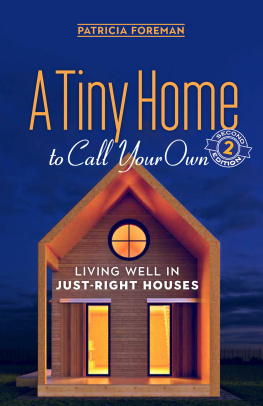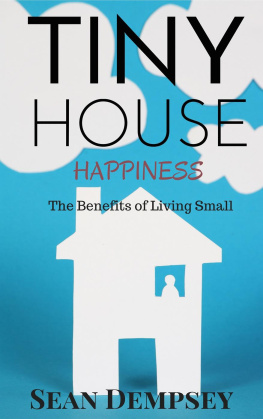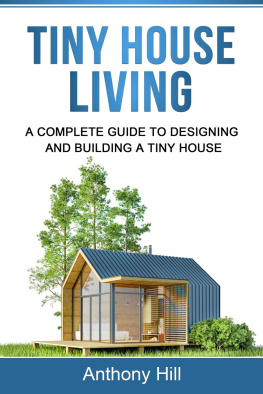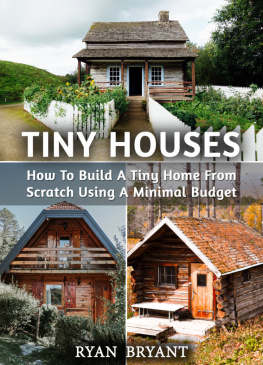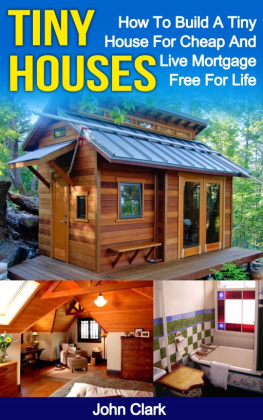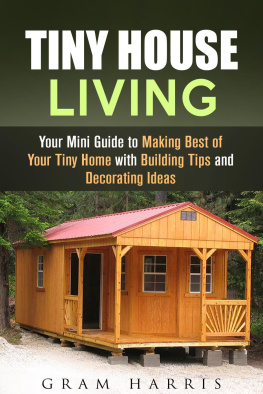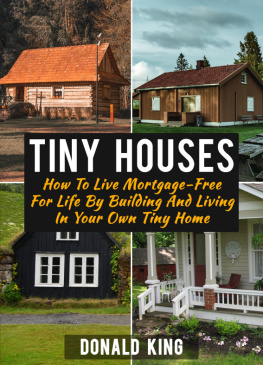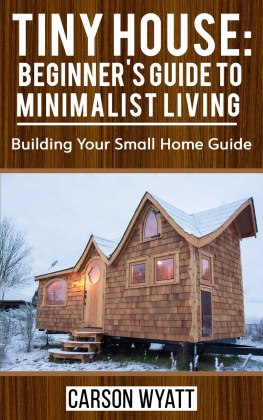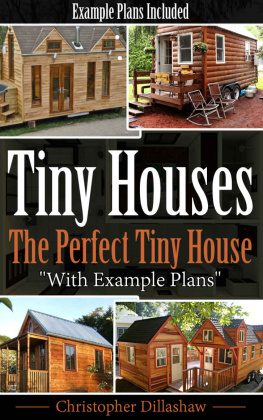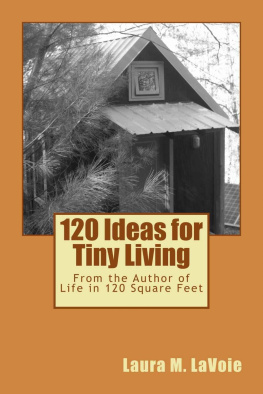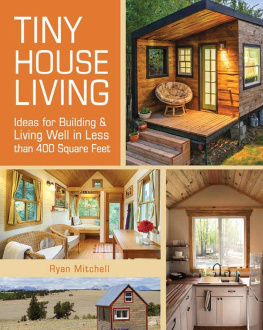Praise for
Tiny Homes
Anyone who wants to live small but comfortably on our delicate planet should snap up this fantastic guide. Packed with persuasive in-depth case studies, tips, and practical floor plans, the book begs the question, Do you really need all that space? Tiny homes are a unique, 21st-century way for us all to live within our means, and in modest but unique fashion.
Rebecca Martin, Group Editor,
Mother Earth News and Grit
To call A Tiny Home to Call Your Own the bible of tiny house living would not be an overstatement. In a well thought out and organized manner, this book covers everything that one should think about when deciding whether or not to live in a tiny house and how to go about doing it. For most people the idea of going tiny is overwhelming and daunting. I believe this book could be one of the most potent tools to help someone overcome the challenges to achieve their tiny house dreams. I only wish that I had this book when I built my tiny house!
Rob Greenfield, author,
Dude Making a Difference
Pat has written an engaging and informative guide for those who wish to consider living lighter on the land and lighter on their budgets, with step by step instructions and documented case studies. We are challenged to examine our own values as part of the design process. Our perfect home may not resemble the one constructed in our mind by our preconceived notions. This book clearly demonstrates that we can indeed live large on a small footprint.
Whether the right size house for you is a tiny house or something larger, this book will guide you through the critical steps to create a dwelling that is exactly what you need nothing more, nothing less a perfect home.
Heidi Louisa Schweizer,
architect & general contractor,
LEED AP BD&C
Copyright 2019 by Patricia L. Foreman
All rights reserved.
Cover design by Diane McIntosh.
Cover image: iStock 477249808.
Woodgrain background: Adobestock 72383843
Printed in Canada. First printing February 2019.
This book is intended to be educational and informative. It is not intended to serve as a guide. The author and publisher disclaim all responsibility for any liability, loss, or risk that may be associated with the application of any of the contents of this book.
Inquiries regarding requests to reprint all or part of A Tiny Home to Call Your Own should be addressed to New Society Publishers at the address below. To order directly from the publishers, please call toll-free (North America 1-800-567-6772), or order online at www.newsociety.com.
Any other inquiries can be directed by mail to
New Society Publishers
P.O. Box 189, Gabriola Island, BC V0R 1X0, Canada
250-247-9737
LIBRARY AND ARCHIVES CANADA CATALOGUING IN PUBLICATION
Title: A tiny home to call your own : living well in just-right houses / Patricia Foreman.
Names: Foreman, Patricia L. (Patricia Louise), 1950- author.
Description: Second edition. | Includes bibliographical references and index.
Identifiers: Canadiana (print) 20190053011 | Canadiana (ebook) 20190053062 | ISBN 9780865718906
(softcover) | ISBN 9781550926835 (PDF) | ISBN 9781771422796 (EPUB)
Subjects: LCSH: Small houses. | LCSH: Architecture, Domestic.
Classification: LCC NA7533 .F67 2019 | DDC 728/.37dc23

New Society Publishers mission is to publish books that contribute in fundamental ways to building an ecologically sustainable and just society, and to do so with the least possible impact on the environment, in a manner that models this vision.

Dedicated to all home dwellers
who are enjoying a larger life in well-fitting homes.
Contents
Introduction
W HY A BOOK ABOUT TINY HOMES? Because when you really look at the U.S. housing inventory, you see that Americans have become obsessed with BIG. From supersized to jumbo. This includes soft drinks, vehicles, and housing. Not everyone wants, needs, or can afford the American Dream JUMBO home.
R. Buckminster Fuller advised his students to look for the gaps in any field. Find the gaps and develop a profitable way to fill them and you will never be lacking for a job or meaningful, useful work to do. In looking at housing many people realize there is a huge gap in choices between what is available and what they want.
Homeowners and house renters in our society can choose from two basic options: (1) huge, mini-mansions that are larger than they really need on the upscale or (2) cheaply made starter homes and plastic single-wide and double-wide manufactured homes on the lower end.
Very little is currently available in U.S. housing that is small yet high quality, handcrafted, and built with individual class and personality. Tiny homes help fill that gap.
The 2010 Census enumerated that the 309 million people in the U.S. lived in 117 million households. Thats an average of 2.6 people per household. That translates to more than ten percent of the U.S. population living alone in 2014.
The trend is clear. Single-person households are expected to reach around 41 million by 2030, an average annual rise of 1.1 percent over 20152030. Single-person households dont need, or even want, a biggie McMansion.
The takeaway is that the average American dream house of three bedrooms, two baths, and a two-car garage is rapidly becoming outdated.
With baby boomers approaching retirement, and more professional single folks in the marketplace, the demand for quality, smaller custom housing is destined to skyrocket. Its a trend that needs to happen on every level: sociologically, environmentally, and economically. People are asking themselves: How much is enough?
While it is true that homebuilders can build any size home you want, most contractors have told us over and over, There isnt any profit in building small houses. The big bucks are made with big houses. This is only partly true.
HomeAdvisor states that the average cost to build a new house in America comes in at $288,642, which would put a 2,000-square-foot home costing about $150 per square foot. This will obviously vary greatly with all the cost variables involved, so the cost could range between $151,839 and $425,445.
As a really rough example, you might expect that if a 2,000-square-foot house at $150 per square foot costs $289,000 to build, then a 1,000-square-foot tiny house would cost $145,500.
It isnt that simple. Smaller homes often cost more per square foot to build. This is because smaller houses have the features of a larger house (kitchen and bathrooms) that are much more costly per square foot to build compared with other rooms in a house, such as bedrooms, sunrooms, and bonus rooms.
That is why tiny and smaller houses can be more expensive per square foot but less expensive overall.
Now heres a big money question. Big houses cost more than little homes. But are they better investments? An article in the May 20, 2001, Seattle Times, written by Elizabeth Rhodes, states,
Judged not on sales price, but on the cost per square foot which reveals how much buyers actually get for their money little houses outperform their bigger brethren not by a little, but by a lot. In the past decade, homes 2,500 square feet or larger have appreciated 57 percent. In 2000 that put the square-foot price at $147. But those under 1,200 square feet in other words your basic two-bedroom, one-bath starter house have appreciated a remarkable 78 percent to $184 per square foot in 2000.
Next page
